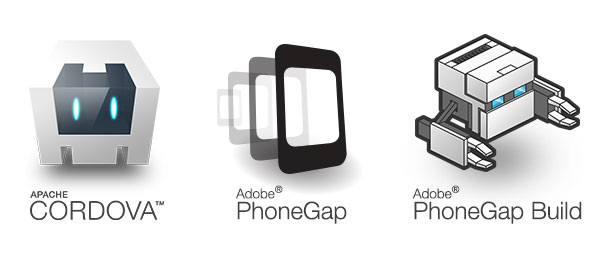
PhoneGap Build
- By Lucid Team
- 27 February 2023

Adobe PhoneGap is a standards-based, open-source development framework for building cross-platform mobile apps with HTML, CSS and JavaScript for iOS, Android, Windows Phone, webOS, BlackBerry and more.
Integrating with PhoneGap Build allowed us to offer a high-end, cost-effective product with Rapid Prototyping Features and, above all, cross-platform development capabilities.
Write a PhoneGap app once with HTML and JavaScript and deploy it to any mobile device without losing features of a native app.
Simply upload your HTML5,CSS, and avaScript assets to the Adobe PhoneGap Build cloud service and they will do the work of compiling for you.
Applications for Phonegap
PhoneGap has a different creation template.
PhoneGap puts config.xml inside of the www folder (which is where PhoneGap Build expects it), whereas Cordova puts it at the root alongside the www directory
PhoneGap allows you to perform remote builds from your machine using PhoneGap Build (phonegap remote build)
PhoneGap's CLI commands are slightly different in format from Cordova despite them largely being a 1:1 wrapper over Cordova
Strengths of PhoneGap:
Build great apps powered by open web standards. Cut down on development time by re-using your existing web dev skills, frameworks and tools.
Get app-store ready apps without the headache of maintaining native SDKs. We do the work for you in the cloud and your app will always be built with the most up-to-date SDK for the platform you are targeting.
Maximize your productivity while minimizing production time. Target iOS, Android, Windows Phone, Blackberry 5/6/7 and webOS all with a single codebase.
We can add team members and create roles within our PhoneGap Build projects. Speed up collaboration.
PhoneGap Build is initiated when a zip file is uploaded containing the www directory of application (including the config.xml file) - this can be via the API or manually via the website. If you are familiar with Cordova then you will know that this means you are missing out on the platforms,plugins and hooks directories.
So how can PhoneGap Build work then? Essentially, PhoneGap Build requires you to add a bunch of custom tags to your config.xml file that instruct it how to build theplugins and platforms directories. If you are new to Cordova/PhoneGap then this might not mean much to you, but that's OK because it means you can get up and running quicker without having to have a deep understanding of them.
PhoneGap is a mobile application development framework, based upon the open source Apache Cordova project. It allows you to write an app once with HTML, CSS and JavaScript, and then deploy it to a wide range of mobile devices without losing the features of a native app.PhoneGap Build is a cloud-based service built on top of the PhoneGap framework. It allows you to easily build those same mobile apps in the cloud.
Public apps have their source code hosted in a publicly accessible GitHub repository. Private apps have their source code hosted in a private (non-publicly accessible) GitHub repository or are created when a developer uploads a ZIP file containing the source code and assets to the PhoneGap Build service.
Application for multiple platforms using PhoneGap Build framework can be developed.
Git-backed public plugins on PhoneGap Build can be used now.
This enables to iterate and test plugins for the apps without the need to upload them to PhoneGap Build or the npm repository.
Adding git-backed plugins to into the phone application is easy and is compatible with the Cordova-CLI config.xml format. All it have to do is add the repository to the attribute of the<plugin /> element in your config.xml. It’s pretty straight forward so we’ll just give some examples:
// install plugin from a git repository (name is optional) <plugin spec="https://github.com/example/cordova-plugin.git" source="git" /> // it doesn't have to be GitHub, it can be any git server <plugin spec="https://bitbucket.org/example/cordova-plugin.git" source="git" /> // if it's a full URI the source attribute is optional, as it'll be assumed // it's git-backed. This also means it's compatible with the Cordova CLI <plugin spec="https://github.com/example/cordova-plugin.git" /> // if you want to reference a tag, branch or single commit or // any commit-ish, add it at the end. Recommended, otherwise it'll // just grab the head of master!!! <plugin spec="https://bitbucket.org/example/cordova-plugin.git#v1.0.1" /> <plugin spec="https://github.com/example/cordova-plugin.git#exp-branch" /> <plugin spec="https://bitbucket.org/example/cordova-plugin.git#61523d1" />
What versions of PhoneGap are supported by PhoneGap Build?
Currently Supported PhoneGap Versions, and their platform breakdowns
| phonegap-version | Android Phonegap Version | iOS Phonegap Version | Windows Phone Phonegap Version |
|---|---|---|---|
| cli-6.1.0
| 5.1.1
| 4.1.0
| 4.3.1
|
| cli-6.0.0
| 5.1.0
| 4.0.1
| 4.3.0
|
| cli-5.4.1
| 4.1.1
| 3.9.2
| 3.8.2
|
| cli-5.2.0
| 4.1.1
| 3.9.1
| 3.8.1
|
| cli-5.1.1
| 4.0.2
| 3.8.0
| 3.8.1
|
| 3.7.0
| 3.7.0
| 3.7.0
| 3.7.0
|
| 3.6.3
| 3.6.3
| 3.6.3
| 3.6.3
|
| 3.5.0
| 3.5.0
| 3.5.0
| 3.5.0
|
| 3.4.0
| 3.4.0
| 3.4.0
| 3.4.0
|
| 3.3.0
| 3.3.0
| 3.3.0
| 3.3.0
|
| 3.2.0
| 3.2.0
| 3.2.0
| 3.2.0
|
| 3.1.0
| 3.1.0
| 3.1.0
| 3.1.0
|
| 3.0.0
| 3.0.0
| 3.0.0
| 3.0.0
|